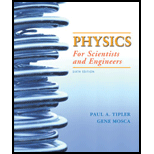
(a)
The proof that
(a)
Answer to Problem 82P
It is proved that
Explanation of Solution
Formula used:
The expression for
The expression for
The expression for
Calculation:
The expression for
The expression for
Conclusion:
Therefore, it is proved that
(b)
The ratio of transmitted intensity and incident intensity.
(b)
Answer to Problem 82P
The ratio of transmitted intensity and incident intensity is
Explanation of Solution
Formula used:
The expression for transmitted intensity for
Calculation:
The ratio of transmitted intensity and incident intensity is calculated as,
Conclusion:
Therefore, the ratio of transmitted intensity and incident intensity is
(c)
The number of slabs.
(c)
Answer to Problem 82P
The number of slabs is
Explanation of Solution
Given:
The refraction index is
Calculation:
The number of slabs is calculated as,
Conclusion:
Therefore, the number of slabs is
Want to see more full solutions like this?
Chapter 31 Solutions
Physics For Scientists And Engineers
- If you have completely polarized light of intensity 150 W/m2 , what will its intensity be after passing through a polarizing filter with its axis at an 89.0 angle to the light’s polarization direction?arrow_forwardTwo polarizing sheets P1 and P2 are placed together with their transmission axes oriented at an angle to each other. What is when only 25% of the maximum transmitted light intensity passes through them?arrow_forwardA linearly polarized microwave of wavelength 1.50 cm is directed along the positive x axis. The electric field vector has a maximum value of 175 V/m and vibrates in the xy plane. Assuming the magnetic field component of the wave can be written in the form B = Bmax sin (kx t), give values for (a) Bmax, (b) k, and (c) . (d) Determine in which plane the magnetic field vector vibrates. (e) Calculate the average value of the Poynting vector for this wave. (f) If this wave were directed at normal incidence onto a perfectly reflecting sheet, what radiation pressure would it exert? (g) What acceleration would be imparted to a 500-g sheet (perfectly reflecting and at normal incidence) with dimensions of 1.00 m 0.750 m?arrow_forward
- A light wave is incident within glass of refractive index nG = 1.50 onto a boundary with water of refactive index nW = 1.33. Calculate the critical angle of incidence in the glass, above which total internal reflection occurs.arrow_forwardThere is a ray of monochromatic light is traveling through air and is incident upon a block of transparent material with an index of refraction of 1.58. If the angle of incidence is 76.1 degrees with respect to the normal of the interface boundary, what is the angle of refraction in the transparent material?arrow_forwardAn optic fiber is a clear solid tube designed to transmit light pulses in a particular direction. To minimize losses, you want light hitting the inside surface of the tube to reflect for as large a range of angles as possible. Should the index of refraction of the fiber be large or small? Why?arrow_forward
- A ray of white light traveling through air enters a triangular prism that has an index of refraction of 1.315 for the red end of the spectrum and 1.345 for the violet end and an apex angle of 72°. If the ray has an angle of incidence of 63° with respect to the normal of the interface boundary, what's the angular separation between the red and violet ends of the spectrum within the prism?arrow_forwardFor an air (n=1) and glass (n=1.45) interface, determine the % of the light reflected (reflectance) and transmitted (transmittance) for a light beam incident from air to glass with (a) incident angle = 25o and the electric field (polarization) direction is in the incident plane, (b) incident angle=25o and electric field (polarization) direction is 45o with respect to the incident plane.arrow_forwardA ray of monochromatic light is traveling through air and is incident upon a block of transparent material with an index of refraction of 1.1. If the angle of incidence is 45.2 degrees with respect to the normal of the interface boundary, what's the angle of refraction in the transparent material?arrow_forward
- A parallel beam of light is incident at 300 to the normal to one face of an equilateral prism (n=1.53), the three faces of which are polished. Trace the path of the light through the prism and find the total deviation produced. For what angle of incidence will the deviation be a minimum?arrow_forwardA ray of light is incident through glass, with refractive index 1.52, on an interface separating glass and water with refractive index 1.32. What is the angle of refraction if the angle of incidence of the ray in glass is 25 °?arrow_forwardA beam of light with wavelength 440 nm in air hits a thin piece of glass 10.28 microns thick (with refractive index 1.55) at an angle of 40.8 degrees to the normal. What is the path difference between the two reflections from the layers of the glass, in wavelengths? [Note to get the phase shift we multiply this number by 2π, but this is modulo 2π, i.e. any integer number of wavelengths are 2π phase shifts, equivalent to no phase shift... basically in terms of phase we only really need the non-integer part of your answer. Note also that for the phase shift we would need to add a π for the reflection off the glass-air interface.]arrow_forward
 Principles of Physics: A Calculus-Based TextPhysicsISBN:9781133104261Author:Raymond A. Serway, John W. JewettPublisher:Cengage Learning
Principles of Physics: A Calculus-Based TextPhysicsISBN:9781133104261Author:Raymond A. Serway, John W. JewettPublisher:Cengage Learning Physics for Scientists and Engineers: Foundations...PhysicsISBN:9781133939146Author:Katz, Debora M.Publisher:Cengage Learning
Physics for Scientists and Engineers: Foundations...PhysicsISBN:9781133939146Author:Katz, Debora M.Publisher:Cengage Learning University Physics Volume 3PhysicsISBN:9781938168185Author:William Moebs, Jeff SannyPublisher:OpenStax
University Physics Volume 3PhysicsISBN:9781938168185Author:William Moebs, Jeff SannyPublisher:OpenStax


